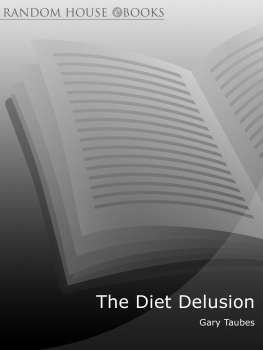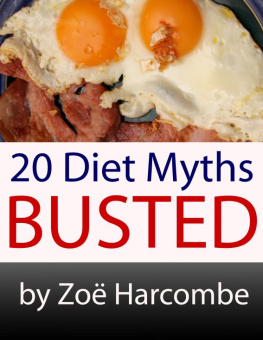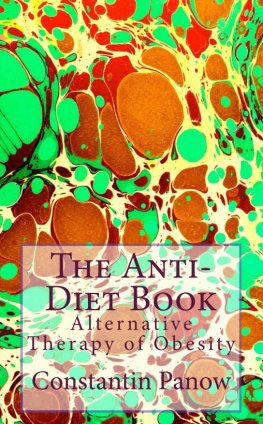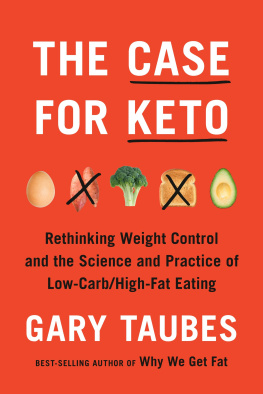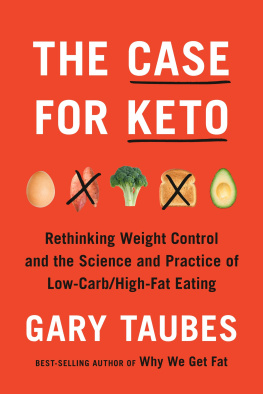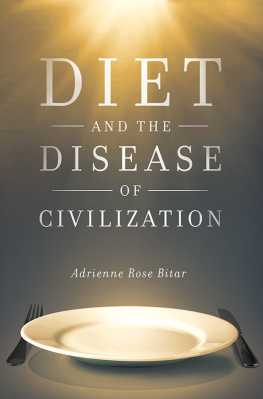Contents
Part One
THE FAT-CHOLESTEROL HYPOTHESIS
Part Two
THE CARBOHYDRATE HYPOTHESIS
Part Three
OBESITY AND THE REGULATION OF WEIGHT
About the Author
Gary Taubes is a correspondent for Science magazine. His articles about science, medicine, and health have appeared in Discover, The Atlantic Monthly, and The New York Times Magazine, among other publications. He has won three Science-in-Society Journalism Awards given by the National Association of Science Writersthe only print journalist so recognizedas well as awards from the Pan American Health Organization, the American Institute of Physics, and the American Physical Society. His writing was selected for The Best American Science Writing 2002 and The Best American Science and Nature Writing 2000 and 2003. He is the author of Bad Science: The Short Life and Weird Times of Cold Fusion, a finalist for the Los Angeles Times Book Award, and Nobel Dreams: Power, Deceit and the Ultimate Experiment. He was educated at Harvard, Stanford, and Columbia. He lives in Manhattan with his wife and their son.
Also by Gary Taubes
Bad Science:
The Short Life and Weird Times of Cold Fusion
Nobel Dreams:
Power, Deceit and the Ultimate Experiment
Praise for the author
The Diet Delusion
Scholarly yet readable deconstruction of dieting the most comprehensive book on the subject.
Good Book Guide
A challenge to conventional wisdom.
Sunday Business Post
This book is a most important contribution to Mankind really an historic book.
Jeremy Stone, longtime president, The American Federation of Scientists
easily the most important book on diet and health to be published in the past one hundred years. It is clear, fast-paced and exciting to read, rigorous, authoritative If Taubes were a scientist rather than a gifted, resourceful science journalist, he would deserve and receive the Nobel Prize in Medicine.
Richard Rhodes, winner of the Pulitzer Prize
Read this, and youll be astonished at the shaky foundations of dietary medicine and health advice First off, I was struck by how little science does know, what we take for established fact if often partial truth at best. Conjectures are, apparently, made on imperfect research compelling reading.
Sue Baker, Publishing News
Nobel Dreams
human and comprehensible Taubes is at his best re-creating in intelligible language the technological excitement [of high energy physics].
Wall Street Journal
an accomplished job [Taubes] paints in full color the joys and tribulations of an immense cast of characters.
Washington Post
One of those rare science books that tells about science in the course of telling about the human comedy, and Taubes has done a masterful job at both Taubes does for high-energy physics what James Watson did for biology.
Los Angeles Times
formidable, well-briefed and pertinacious The boundary between journalism of this caliber and serious contemporary history has become blurred A man who has spent a year with a tape-recorder in the mephitic caverns of CERN will carry marks to compare with those of Hunter Thompson on the roadhouse floor, or George Plimpton, plastered into the mud of the stadium in Detroit.
Nature
a rare inside look at particle physics.
Time Magazine
Bad Science
Taubes tale of the cold-fusion craze, enriched by his supple command of the physics involved, is punctuated throughout with irony and skepticism.
New Yorker
based on an astonishing depth of reporting [Taubes gives] the story both an engagingly human dimension and a commandingly synoptic scope.
Washington Post
a case study in the sociology of science, as well as an often hilarious chronicle of the extremities of human folly Bad Science furnishes many serious lessons for the historian. Just as physiologists learn about the bodys normal functions from its pathology, young researchers might usefully study this book, since it bears compelling witness to the human minds irrepressible propensity for self-delusion.
Nature
a detailed, wry and definitive history of one of our centurys grandest scientific hoaxes.
Los Angeles Times
Gary Taubes has written a powerful, tense description of the cold fusion affair, a depressing incident in recent science history. Exhaustive research and a lively journalist style provide the reader with a stranger-than-fiction account of the decline and fall of two respectable chemists and their university administrator accomplices. [Bad Science] is more than a contribution to history, it is an instructive popular account of how good science operates and what can go wrong. As such, it contributes to the crucial task of popular literacy.
Leon Lederman, Nobel Prize for Physics, 1988
Bad Science is great, a spellbinding story of science gone wrong.
Burton Richter, Nobel Prize for Physics, 1976
The story of cold fusion as told in this marvelous volume reads like a combination soap opera and mystery. If you want to gain a deep understanding of how science should and should not be done, this is the story that will do it for you. Whether you are a scientist or not, you wont be able to put it down.
Mel Schwartz, Nobel Prize for Physics, 1988
Unfortunately, Bad Science is an all-too-accurate summary of the furor over cold fusion. Gary Taubes has given us the definitive study of how a large part of the scientific community fortunately not all fell apart in the false light of a potentially infinite energy source.
F.S. Rowland, former chairman, American Association for the Advancement of Science
Taubes has written an absorbing, blow-by-blow account of the cold fusion fiasco a penetrating and balanced dissection of pathological science.
Glenn T. Seaborg, Nobel Prize for Chemistry, 1951
FOR
SLOANE AND HARRY, MY FAMILY
Prologue
A BRIEF HISTORY OF BANTING
Farinaceous and vegetable foods are fattening, and saccharine matters are especially so. In sugar-growing countries the negroes and cattle employed on the plantations grow remarkably stout while the cane is being gathered and the sugar extracted. During this harvest the saccharine juices are freely consumed; but when the season is over, the superabundant adipose tissue is gradually lost.
THOMAS HAWKES TANNER , The Practice of Medicine, 1869
WILLIAM BANTING WAS A FAT MAN . In 1862, at age sixty-six, the five-foot-five Banting, or Mr. Banting of corpulence notoriety, as the British Medical Journal would later call him, weighed in at over two hundred pounds. Although no very great size or weight, Banting wrote, still I could not stoop to tie my shoe, so to speak, nor attend to the little offices humanity requires without considerable pain and difficulty, which only the corpulent can understand. Banting was recently retired from his job as an upscale London undertaker; he had no family history of obesity, nor did he consider himself either lazy, inactive, or given to excessive indulgence at the table. Nonetheless, corpulence had crept up on him in his thirties, as with many of us today, despite his best efforts. He took up daily rowing and gained muscular vigor, a prodigious appetite, and yet more weight. He cut back on calories, which failed to induce weight loss but did leave him exhausted and beset by boils. He tried walking, riding horseback, and manual labor. His weight increased. He consulted the best doctors of his day. He tried purgatives and diuretics. His weight increased.
Next page
